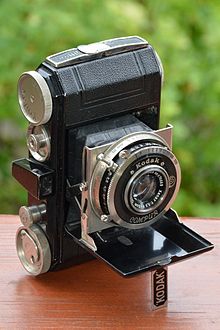Kodak Retina
Kodak Retina was the name of a line of cameras made by Kodak . They were manufactured in the Nagel camera factory in Stuttgart, which Kodak had acquired in 1931. The cameras were built from 1934 to 1969, the first model was the Kodak Retina (Type 117), see picture on the right. Kodak's Retina is without a doubt a milestone in camera history. With it, Kodak introduced the most successful form of packaging for photographic film to date, the 35mm film : the 35mm cartridge , also known as the 135 cartridge . The Retina was aimed at discerning amateurs and had high-quality lenses and the best central shutters available at the time with a large time series, which also allowed night shots, sports shots and flash shots with all times. Comprehensive system accessories were gradually developed for the retina, which made it possible to solve even very demanding photographic recordings. However, this became less important when ever cheaper miniature reflex cameras appeared, which, due to their system, were simply better suited for many tasks.
A simpler line for the casual photographer was the Kodak Retinette .
The Kodak Retina IIc, IIC, IIIc and IIIC had interchangeable lenses which, in combination with the basic lens, which was firmly attached to the camera body, formed a slight wide angle and a slight telephoto. The standard lenses available were Retina Xenon C, with f: 2.8 / 50 mm (IIc / IIC) or f: 2.0 / 50 mm (IIIc / IIIC) from Schneider-Kreuznach and corresponding lenses from Rodenstock. For telephoto shots Retina Longar-Xenon C or Retina Heligon f: 4/80 mm. For wide-angle images Retina Curtar-Xenon C or Retina Heligon C f: 4/35 mm or Retina Curtar-Xenon C or Retina Heligon C f: 5.6 35 mm. Three light frames reflected in the IIC and IIIC showed the respective image details. The wide-angle and telephoto conversion lenses were absolutely state-of-the-art in terms of image quality, but the distance setting was rather cumbersome: first the distance had to be determined using the rangefinder and then transferred to the auxiliary lens on the underside of the lens body. Taking photos quickly was only possible with preset distances. The shutter speeds were fully synchronized ( M and X synchronization ) up to the shortest shutter speed of 1/500 s. The self-timer offered 10 s lead time.
history
The IIIc, presented at Photokina in 1954, was the first retina model to have a built-in light meter. Exposure meters became more and more important at this time, because increasingly color negative and slide films were used, which were significantly more critical to exposure than black and white film. It was equipped with the Schneider Kreuznach Xenon-C 50 mm F2 six-lens lens . In addition, the retinas with the capital "C" in the model designation had a very large viewfinder, which made it much easier to create images, especially with slide film. The camera shutter of the type Synchro Compur made to an exposure time of 1/500 to 1 second. With the series, a quick-action lever at the bottom and a shutter control were also introduced, which automatically created suitable time-aperture combinations with a certain light value setting. Due to the complex mechanics, the camera housing grew considerably in volume, but there was still the folding tube. However, the cameras could no longer be closed with attached telephoto and wide-angle lenses.
With what is probably the most advanced Retina IIIs, the principle of the folding camera was consequently abandoned. In contrast to the "c" and "C" models, the IIIs also had real interchangeable lenses from 28mm - 135mm, for which the matching viewfinder frames were automatically reflected in the viewfinder. An absolute specialty was that a series of these interchangeable lenses could also be used on the Retina Reflex S, III and IV. At the same time, they said goodbye to the cumbersome distance setting with the auxiliary lenses for the "C" and "c" models. Now the distance setting of the rangefinder was determined directly via the lens attached. Since the IIIs still had a central shutter, fully synchronized flash photos with all shutter speeds were also possible with it. That was a big advantage compared to the focal plane SLR cameras of the time, which only offered synchronization times between 1/25 and 1/60 s.
Overview of the models
- Kodak Retina
With folding tube
- Retina (type 117/118, 1934-1936)
- Retina I (type 119/126/141/143/148/149/167/013, 1936–1950)
- Retina Ia (type 015, 1951–1954)
- Retina Ib (type 018, 1954–1957)
- Retina IB (type 019, 1957-1960)
- Retina II (Type 142, 1936–1950)
- Retina IIa (type 150, 1939, type 016, 1951–1954)
- Retina IIc (type 020, 1954–1957)
- Retina IIC (type 029, 1957–1958)
- Retina IIIc (type 021, 1954–1957)
- Retina IIIC (type 028, 1957-1960)
Not foldable
- Retina IIIS (type 027, 1958-1960)
- Retina IIS (type 024, 1959-1960)
- Retina Automatic I (Type 038, 1960–1962)
- Retina Automatic II (Type 032, 1960–1962)
- Retina Automatic III (Type 039, 1960–1963)
- Retina I BS (type 040, 1962–1963)
- Retina IF (type 046, 1963–1964)
- Retina IIF (type 047, 1963–1964)
- Retina S1 (type 060, 1966–1969)
- Retina S2 (type 061, 1966–1969)
SLR camera
- Retina Reflex (Type 025, 1957–1958)
- Retina Reflex S (type 034, 1959–1961)
- Retina Reflex III (type 041, 1961–1964)
- Retina Reflex IV (Type 051, 1964–1966)
Web links
Individual evidence
- ↑ http://knippsen.blogspot.co.at/2012/07/kodak-retina-i.html
- ↑ Archived copy ( memento of the original from June 20, 2010 in the Internet Archive ) Info: The archive link was inserted automatically and has not yet been checked. Please check the original and archive link according to the instructions and then remove this notice.
- ↑ Archived copy ( Memento of the original from May 16, 2011 in the Internet Archive ) Info: The archive link was inserted automatically and has not yet been checked. Please check the original and archive link according to the instructions and then remove this notice.
- ↑ http://homepages.ihug.co.nz/~Srawhiti/retina3cchanges.html










